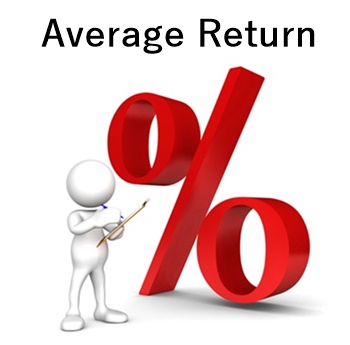
Table of Contents
Defining Average Return
Average return is the mathematical average of a series of returns generated over a period of time. An average return is calculated the same way as a simple average is calculated. The numbers are added together into a single sum, and then the sum is divided by the count of the numbers in the set.

The average return on a Portfolio of stocks can show how well your investments have worked over a period of time. This also helps to predict future returns. The simple average of returns is an easy calculation, but it is not very accurate. To calculate accurate returns, analysts frequently use the geometric mean return or the money-weighted return.
There are several return measures. Three of the most popular are:
- Return on Assets (ROA)
- Return on Investment (ROI), and
- Return on Equity (ROE)
How to Calculate Average Return?
To calculate the average return, there is a variety of measures and ways. However, the most prevalent average return formula is:
Average Return = Sum of Returns / Number of Returns
Here, the simple growth rate is one of the balances' or values' functions that start and end. It is comprehended by deducting the end value from the start value. Then, the output is divided by the start value.
So, the growth rate formula is:
Growth Rate = (BV – EV) / BV
Here,
- BV = Beginning Value
- EV = Ending Value
Talk to our investment specialist
Average Return Example
One of the examples of average return is the simple arithmetic mean. For instance, suppose you have invested somewhere. And, annually, for five years, you acquired the following return:
5%, 10%, 15%, 20% and 25%
If you add them together and divide the number by 5, your average return will be calculated. This means, in the five years, you got 15% of the average return.
What is Geometric Average Return?
If the historical measures of calculating average return are considered, one of the ways of calculation is the geometrical average. The geometric average return is often known as the Time-Weighted Rate of Return (TWRR), considering that it excludes the impact of inaccurate growth levels generated over the period by various inflows and outflows of money into an account.
On the other hand, the Money-Weighted Return Rate (MWRR) comprises the timing and size of cash flows, making it an impactful measure for portfolio returns received on withdrawals, interest payments, dividend reinvestments and deposits.
In comparison to the average return, the geometrical mean always remains inferior. However, one of the advantages of using the geometric mean is that there is no requirement to learn the accurate number of sums that have been invested. This calculation entirely concentrates on the return figures.
Accurate Average Return Measures
The geometric average is a more precise calculation. The benefit of using the geometric mean is that the actual amounts invested do not need to be known. This calculation presents an "apples to apples" comparison when looking at multiple investments' performance over more various time periods.
The geometric average return is also called as Time Weighted Rate of Return (TWRR).
The geometric formula is:
[(1+Return1) x (1+Return2) x (1+Return3) x ... x (1+Returnn)]1/n - 1
Average Rate of Return
The average rate of return (ARR) is the average amount of cash flow generated over the life of an investment. ARR is usually annualized. It does not account for the time value of money. That is why many use ARR in conjunction with other metrics when considering large financial decisions. Both average return and ARR are commonly used methods of determining relative performance levels.
Annualized Return vs Average Return
Annualized return is compounded when penning down previous returns. On the other hand, average return doesn't regard compounding. An Average Annual Return, normally, is used to evaluate returns of varying equity investments. But, since it compounds, the annual average return is generally not considered an adequate analysis metric. Thus, it is rarely used to assess changing returns. Moreover, the annualized return is calculated through a regular mean.
Wrapping Up
Despite the effectiveness and ease of measurement for internal returns, you must keep in mind that the average return has a variety of pitfalls. It doesn't account for varying projects that may need diverse Capital outlays. Thus, when using this metric for your benefit, assess every aspect before completely depending on it.
All efforts have been made to ensure the information provided here is accurate. However, no guarantees are made regarding correctness of data. Please verify with scheme information document before making any investment.












